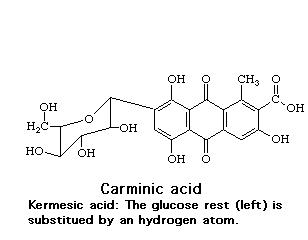About the chemical structure:
| Chemical name: | Carminic acid (Cochineal), kermesic acid (Kermes) |
| Formula: |
|
| 3D model: |
grey = carbon, red = oxygen, white = hydrogen |
| Refractive index: | about 1.6 |
Color:
| Color Index (C.I.) | Natural Red 4 (75470) (cochineal) |
How can you identify Carmine lake?
Imaging:
UVF: dark red
OM: Appears quite transparent in transmitted light. Does not exhibit birefringence or polarization colours and therefore dulls and darkens to black under cross-polars.

Microscopic appearance at x500 mag
Analytics:
Carmine lakes can be identified by means of FTIR.
FTIR spectra: IRUG; Integrated Spectral Data Base System for Organic Compounds, Japan
Usage and handling:
| Permanence: | Toxicity: |
|---|---|
Lightfast: poor. Degradation processes: The cochineal lakes are not permanent to light. They turn brownish and then fade rapidly in strong sunlight, particularly when used in water color. In oil, however, they are fairly permanent.
Above, The Paston Treasure, unknown though most likely Dutch artist, 1665, The Yarmouth Collection The most striking characteristic of the painting today is its two-dimensional almost decoupaged quality. This is partly due to the result of fading and the loss of subtle mid-tones. Investigation of the artist’s materials and painting technique supplied some insight into the extensive degradation of the paint layer, which greatly impacts the colour balance and nuance of the composition. By re-tracing the artist’s creative process via reconstruction, intentional and incidental changes to the paint layer could be identified and recreated to give some impression of the painting’s original presence. The area of reconstruction was strategically chosen to encompass areas of notable colour shift including the little girl at the foreground, the lobster, two nautilus cups and a Wan-li porcelain bowl, passages known to contain the light-sensitive pigments smalt, cochineal and yellow lake. Figure bottom left. The first stage of reconstruction involved covering the canvas with a pinkish-gray ground or imprimatura. It was fairly important to get the imprimatura colour correct. A tracing of the original painting was transferred to the copy canvas with white chalk. Figure on bottom center. In keeping with traditional seventeenth century practise, each component of the composition was blocked in with a general ‘dead-colour’ comprised of fairly simple pigment mixtures. figure on bottom rigth . In the next stage, known as the ‘working up’ process, greater attention was given to the three-dimensionality of each form. Shadows and highlights were added to the flesh tones of the little girl, and the parrot’s feathers were articulated with loose brushstrokes of azurite and ivory black. Based on technical analysis, an even glaze of cochineal mixed with a large proportion of chalk was applied to the lobster, save one claw (which was preserved for comparison). Pure cochineal was added to several other areas of the painting, all of which demonstrate some level of fading or discoloration, such as the tablecloth beneath the still-life, the gray parrot’s tail feathers and the little girl’s hair ribbons. |
non toxic. Cochineal and kermes are not toxic, and in fact they used by industry to color food and beverages. Care, however, should always be exercised when handling dry powders (such as when the cochineal is pulverized) so as not to inhale the dust. MSDS: Kremer
|
Literature:
Artists’ Pigments A Handbook of Their History and Characteristics, Vol. 1, L. Feller, Hrsg., Cambridge University Press, London 1986, p. 255-284
Fleming, S. "The Tale of the Cochineal: Insect Farming in the New World." Archaeology, 36, no. 5 (1983), pp. 68-69, 79.
Cochineal und Karminsäure, Neue Zürcher Zeitung 11.12.1996
Pigmentlexikon
The Investigation and Reconstruction of a Seventeenth Century Pronk Still Life: The Yarmouth Collection, Research at the Hamilton Kerr Institute




